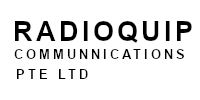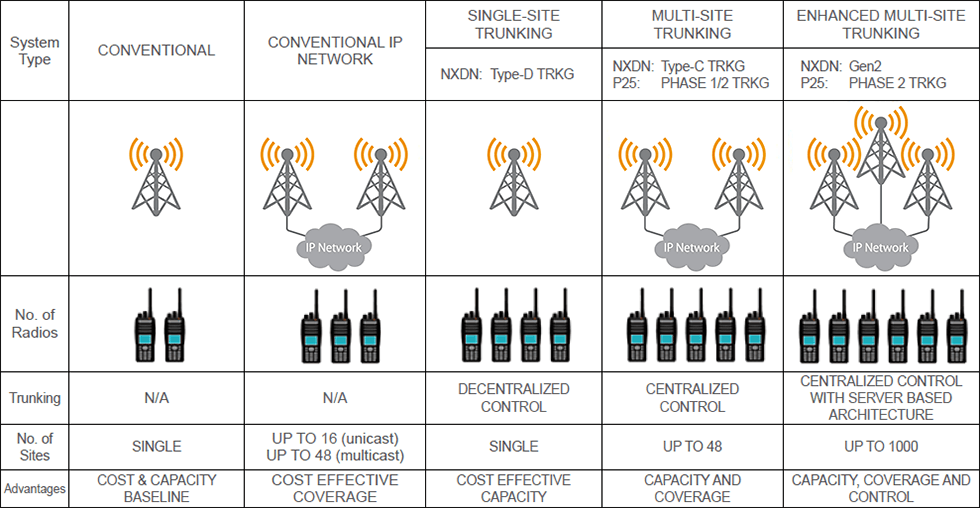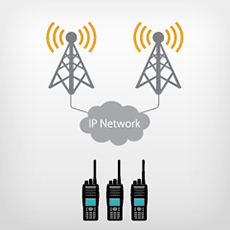Radio Communication Network Design and Implimentation.
Conventional Setup
For smaller groups of users, a conventional architecture should prove sufficient while requiring less investment. DMR’s two-slot TDMA scheme is a cost-effective way to migrate from analog FM, since it is possible to obtain 2 talk paths within the same 12.5 kHz bandwidth, doubling capacity.
Also, KENWOOD DMR radios enable up to two simultaneous direct-mode subscriber calls in a 12.5 kHz channel without a base station or repeater.
Alternatively, NXDN FDMA digital 6.25 kHz offers 20% longer range, thus extending coverage area by 50%. This is because both bandwidth and band-pass filters are narrower, so carrier-to-noise ratio (CNR) is improved compared with 12.5 kHz.
Suitable for Retail
and Hospitality
Conventional IP Network
For a large organisation, multiple repeaters can be connected to an IP network. This inexpensive solution allows voice and data to be exchanged between sites.
Conventional IP networks link digital conventional repeaters into one system for wide area coverage or to provide coverage fill-in extensions.
As users roam through the network, subscriber units use beacon signals to select the best repeater.
Subscriber zones can be programmed for Channel Select for traditional conventional operation, or Automatic Site Roam, which allows subscriber units to scan for site beacon signals to lock onto for network calls.
Receiver Voting systems extend the portable talk-in range of a conventional repeater by utilising a constellation of satellite receivers linked to the repeater site.
Based on radio signal strength data (RSSI) sent via IP link, the repeater site selects the receiver site with the best audio quality for re-transmission.
Suitable for Security Guard
and Factory
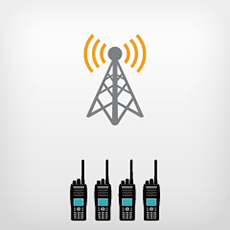
Slide title
Write your caption hereButton
Single Site Trunking
This cost-effective solution, offers spectrum efficiency and simplicity.
NXDN Type-D Trunking is the FB6*-based digital LTR protocol specified by the NXDN Forum.
Unlike Type-C trunking, there is no dedicated control channel: trunking is under the control of the home repeater assigned to each radio. And like LTR, there is no registration. This cost-effective solution thus offers spectrum efficiency and simplicity.
Suitable for School, Polytechnic
and University campuses
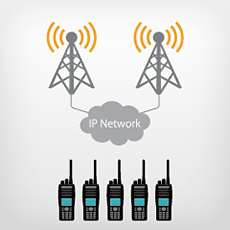
Slide title
Write your caption hereButton
Multi-site Trunking
NXDN Type-C Trunking is the FB8*-based full-featured digital protocol specified by the NXDN Forum and used for NEXEDGE since 2007. Type-C is otherwise known as centralised trunking; this is because, unlike Type-D, trunking is controlled centrally using a dedicated control channel that is continuously transmitting and receiving. As with MPT 1327, registration is required.
P25 Phase 1 (FDMA scheme) can also be used in a robust and reliable trunked configuration for larger organisations. Since the channels are assigned automatically, this provides greater capacity.
P25 Phase 2 (two-slot TDMA scheme) requires only 6.25 kHz of bandwidth and thus offers higher spectrum efficiency.
Suitable for Mass Transportation Company, Hotels
and Casinos
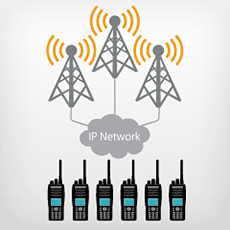
Slide title
Write your caption hereButton
Enhanced Multi-site Trunking System
NEXEDGE Generation 2 (Gen2) offers a quantum leap in network size: the maximum number of sites than can be connected has increased from 48 to 1,000, representing virtually unlimited scalability. At the same time, it provides full compatibility with current equipment. For enterprises looking to create large-scale digital trunked networks, Gen2 has the features, capabilities and performance to satisfy all their requirements.
Suitable for Airports, Utilities Companies
and First Responders
